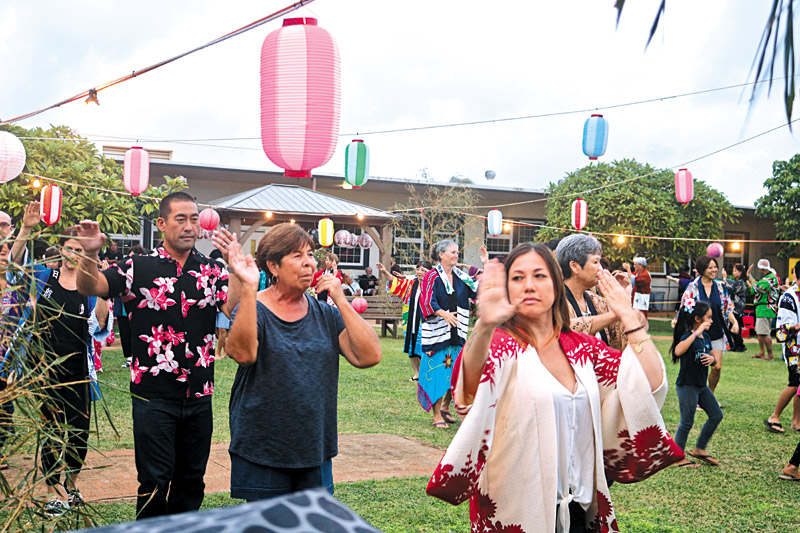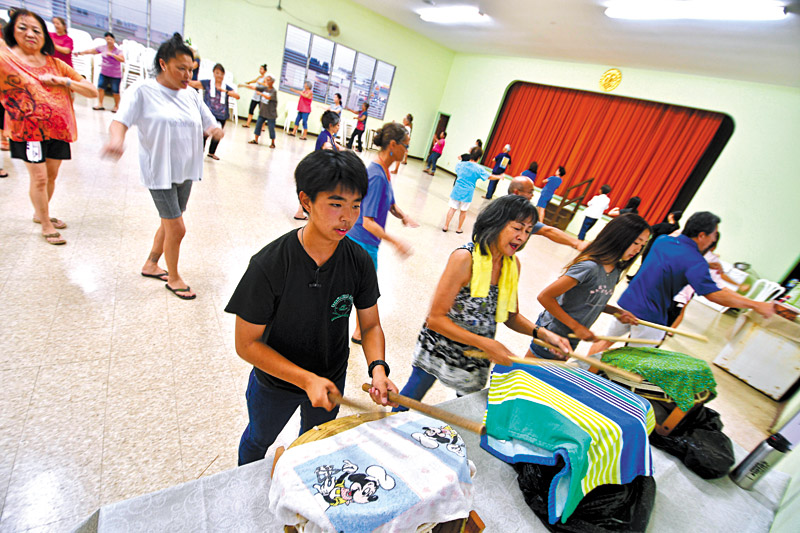Bon Comes Into Season

Dancers parade around Mahelona Medical Center at last year’s event. Leading the line is Cheryl Morita (right), the daughter of volunteer Elaine Morita, who started the tradition of Bon dance at the hospital.
The ancient tradition of Bon is alive and well on the Garden Isle, where the practice is perpetuated and shared with all generations.
Beginning in 1885, when the first big wave of Japanese plantation workers immigrated to Hawai‘i, one of the most enduring traditions they brought with them was the Buddhist practice of honoring the spirits of their ancestors. This custom, known as Obon, or Bon, has been celebrated in Japan for more than five centuries, and to this day, the Bon festival and Bon odori (dance) remains a cherished part of Kaua‘i’s immigrant culture and history.
Bon season typically runs from June to August, though this year, May marks the beginning of festivities.
Bon festivals are a celebration of ancestors returning for a visit during the summer. In different sects, at the conclusion of Bon season, the spirits are then sent back to nirvana on floating lanterns, or with the burning of tablets with their names.
“In the early days, Obon festivals started with only iwakuni,” explains Pearl Shimizu, president of Kaua‘i Japanese Cultural Society. “Iwakuni is where a live singer would stand up on the yagura (tower), and drummers would keep the beat for the singer.”
For the state’s early Japanese immigrants, this social event was representative of Bon festivals — that is, until churches were established.
Since the inauguration of Buddhist and Shinto missions, the Buddhist Council features a representative from each church. It is responsible for creating the festival schedule, and Bon dances have become celebrated events in nearly every town. Yagura are built in the front courtyards of churches throughout the island; hanging lanterns are raised into place; dancers and drummers converge on the church halls for practice; and the tradition continues.
For Shimizu, Bon festivals have always been a part of her summer memories. She first learned Bon dance as a child. She danced through her teenage years and then again after returning from college. Since 1986, she has served as Bon dance instructor for Kapa‘a Hongwanji.
“My favorite memories are (from) when I was young,” says Shimizu. “I could last through the night until the end of the dance.”
While she may not dance the entire evening as she once did, she can now pass on the spirit of Bon odori to the next generation of dancers.
“What I look forward to (now) is teaching the dances and the meaning of each dance, and watching the dancers that learned the dances as beginners and seeing them progress as each dance festival goes by,” she adds.
Shimizu, like many other Kaua‘i residents, awaits with eager anticipation hearing the first upbeat sounds of those familiar songs blaring over the loudspeakers.
There is the excitement and beauty of seeing dancers dressed in traditional happi coats or brightly designed kimono and obi (sashes) with ornate kanzashi (hair ornaments).
The best part is that everyone can participate. There is 90-year-old taiko drummer Freckie Okada, and seasoned dancers Mitsuko Valdez, Toshiko Kaneshiro and Yuki Sokei, and there are keiki as young as 3 learning the dances for the first time.
“This is an important cultural tradition to honor our ancestors, so it is important, the passing of the dancing and drumming on to the next generation,” Shimizu says. “Even the Iwakuni singing needs to be passed on to next generation. This Iwakuni is not being sung in Japan where it originated.
Hawai‘i is keeping this form of singing alive.”
In preparation for Bon festivals, Kaua‘i Japanese Cultural Society will be conducting a kimono and obi dressing workshop to teach people the proper way of wearing the different parts of the kimono.
The class takes place from 11 a.m. to noon May 25 at Līhu‘e Neighborhood Center. Participants are asked to bring a yukata (summer kimono), two or three himo (ties), datemaki (narrow sash that goes under the obi), obi ita (obi board), as well as underwear like hadajuban (undershirt), koshimaki (slip) or nagajuban (long slip).
For more information on Bon dance and upcoming events, call 822-5353 or visit kauaijcs.org.
2019 Kaua‘i Bon Dance Schedule
All bon dances start at 7:30 p.m. Schedules are tentative.
May 17 • Mahelona Medical Center
May 31-June 1 • Kaua‘i Soto Zen Temple Zenshuji
June 7-8 • Kōloa Jodo Mission
June 14-15 • West Kaua‘i Hongwanji Mission
June 21-22 • Līhu‘e Hongwanji Mission
June 28-29 • Waimea Shingon Mission
July 12-13 • Kapa‘a Jodo Mission
July 19-20 • Waimea Higashi Hongwanji
July 26-27 • Kapa‘a Hongwanji Mission
Aug. 9 • Kaua‘i Veterans Memorial Hospital





